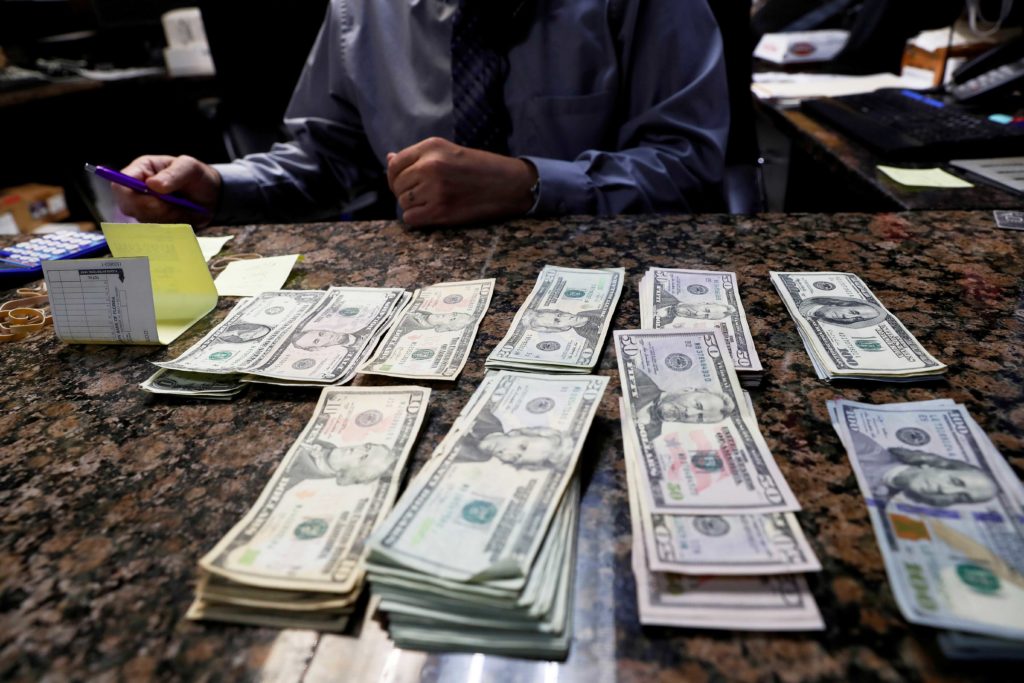Fiscal stimulus fires up U.S. consumer spending; inflation benign

Carlos Gonzalez, managing partner of the Oz Ladies’ and Gentlemen’s Nightclub, counts money ahead of the Tampa Bay area weekend NFL’ Super Bowl LV amid the ongoing spread of the coronavirus disease (COVID-19) at in Clearwater, Florida, February 5, 2021. REUTERS/Shannon Stapleton/File Photo
WASHINGTON – U.S. consumer spending increased by the most in seven months in January as the government doled out more pandemic relief money to low-income households and new COVID-19 infections dropped, positioning the economy for faster growth in the first quarter.
Despite the strong rebound in consumer spending reported by the Commerce Department on Friday, price pressures were muted. Inflation is being closely watched amid concerns from some quarters that President Joe Biden’s proposed $1.9 trillion COVID-19 recovery package could cause the economy to overheat.
The plan, being considered by the U.S. Congress, would be on top of a rescue package worth nearly $900 billion approved by the government in late December. Federal Reserve Chair Jerome Powell has played down the inflation fears, citing three decades of lower and stable prices.
“Thanks to Washington, the economic outlook in the near future is sunny,” said Sung Won Sohn, finance and economics professor at Loyola Marymount University in Los Angeles.
Consumer spending, which accounts for more than two-thirds of U.S. economic activity, jumped 2.4% last month. That was the biggest gain since last June and ended two-straight monthly declines. Personal income shot up 10%, the largest increase since last April when the government disbursed the first round of stimulus checks. Income rose 0.6% in December.
The recent stimulus package included $600 checks to mostly low-income and some middle-income Americans. The package also extended a government-funded weekly unemployment subsidy as well as benefits for millions of people who do not qualify for state unemployment programs as well as those who have exhausted their six months of eligibility. These benefits expire in mid-March.
The consumer spending report added to upbeat data this month on manufacturing output, building permits and home sales.
Consumers bought motor vehicles, recreation goods, food and beverages. They also boosted spending on services such as hotel accommodations and restaurants, as well as doctor visits.
Economists polled by Reuters had forecast consumer spending rebounding 2.5% in January and income accelerating 9.5%.
U.S. stocks were trading lower. The dollar rose against a basket of currencies. U.S. Treasury yields fell.
When adjusted for inflation, consumer spending increased 2% last month after decreasing 0.8% in December. But robust consumer spending is drawing in imports.
In a separate report on Friday, the Commerce Department said the goods trade deficit increased 0.7% to $83.7 billion last month, with imports outpacing a rise in exports. The department also reported a 0.6% decrease in retail inventories, though stocks at wholesalers surged 1.3%.
The drag on economic growth from the widening goods trade deficit and slower pace of inventory accumulation will likely be blunted by the strong consumer spending.
Following this month’s slew of solid reports, Morgan Stanley raised its first-quarter gross domestic product growth estimate to an 8.1% annualized rate from a 7.3% pace. Growth forecasts for the quarter were boosted last week from as low as a 2.3% pace. The economy grew at a 4.1% rate in the fourth quarter.
There are indications that the White House’s massive stimulus package could be fully approved next month. It would send additional $1,400 checks to qualified households and extend the government safety net for the unemployed.
Further gains in consumer spending are likely, though winter storms, which wreaked havoc in Texas and other parts of the densely populated South this month, could slow momentum. Daily coronavirus cases and hospitalizations have dropped to levels last seen before the Thanksgiving and Christmas holidays, while the pace of vaccination is picking up.
While a third report from the University of Michigan showed its consumer sentiment index dipping this month from January, a survey from the Conference Board this week showed an improvement in confidence among households.
Graphic: Consumer sentiment – https://graphics.reuters.com/USA-STOCKS/gjnpwzzjmvw/umich.png
Inflation was benign last month. The personal consumption expenditures (PCE) price index excluding the volatile food and energy component rose 0.3% after a similar gain in December. In the 12 months through January, the so-called core PCE price index increased 1.5% after advancing 1.4% in December.
The core PCE price index is the Fed’s preferred inflation measure for its 2% target, a flexible average.
Powell this week told lawmakers that the U.S. central bank would keep interest rates low and continue to pump money into the economy through bond purchases “at least at the current pace until we make substantial further progress towards our goals (maximum employment and inflation).”
There is ample slack in the labor market, with at least 19 million people on unemployment benefits.
Income last month was boosted by a 52% surge in government transfers. It was also supported by a 0.7% rise in wages. Excluding the government largesse income at the disposal of households after inflation fell 0.5%.
Some of the stimulus money sent to households was stashed away, hoisting the saving rate to 20.5% from 13.4% in December.
“We expect an additional stimulus package passed in March to raise the savings rate further, adding to a powerful tailwind of buying power that has been building among U.S. households, ready to be deployed as the economy is reopening,” said Ellen Zentner, chief economist at Morgan Stanley in New York.

